Physics Beyond 2000 Chapter 3 Circular Motion http

Physics Beyond 2000 Chapter 3 Circular Motion http: //www. glenbrook. k 12. il. us/gbssci/phys/mmedia/circmot/ucm. html

Uniform Circular Motion • The path is the circumference of a circle with constant radius r. • The speed is a constant. • The direction of motion changes with time. r v

Uniform Circular Motion • The path is the circumference of a circle with constant radius r. • The speed is a constant. • The direction of motion changes with time. r

Uniform Circular Motion • The path is the circumference of a circle with constant radius r. • The speed is a constant. • The direction of motion changes with time. v v r v v

Uniform Circular Motion • Period T is the time needed to complete one cycle. • Frequency f is the number of cycles completed in one second. r

Uniform Circular Motion • Example 1

Uniform Circular Motion • Angular displacement – It is the angle, in radian, that the object turns. r

Angular displacement • Angular displacement – It is the angle, in radian, that the object turns. s Length of arc s = r. r

Angular displacement • After one complete cycle, angular displacement θ= 2π

Angular displacement • Example 2

Angular speed • Definition of average angular speed, ωav – Δθis the angular displacement – Δt is the time taken

Angular speed If we consider one complete cycle, Δθ= 2π and Δt = T then ωav = 2πf

Angular speed • Example 3

Instantaneous angular speed

Instantaneous angular speed Example 4

Angular speed and linear speed Δs B v A Δθ O r X • When the object moves from A to B at linear speed v, • Δs = r. Δθ v = r. ω

Angular speed and linear speed • Example 5

Centripetal acceleration • In a uniform circular motion, the velocity v changes in direction but not in magnitude. • It requires an acceleration a to change the direction of the velocity but not the v magnitude. • The acceleration must be always a perpendicular to the velocity.

Centripetal acceleration In time Δt, the object moves from A to B. v. B B v. A A Δθ O r |v. B| = |v. A| = v X

Centripetal acceleration In time Δt, the object moves from A to B. v. B B v. A A Δθ O r |v. B| = |v. A| = v X

Centripetal acceleration In time Δt, the object moves from A to B. v. B B Note that the triangle is an isosceles triangle. v. A A Δθ O r |v. B| = |v. A| = v X Δθ

Centripetal acceleration In time Δt, the object moves from A to B. v. Δθ= a. Δt v. B B v. A A a= Δθ O r |v. B| = |v. A| = v X Δθ

Centripetal acceleration v. B B v. A A Δθ O r |v. B| = |v. A| = v X Δθ

Centripetal acceleration The acceleration is pointing to the centre of the circle. v. B B v. A A Δθ O r |v. B| = |v. A| = v X Δθ

Centripetal acceleration v a O r The acceleration is pointing to the centre of the circle. The magnitude of the acceleration is or r. ω2 X

Centripetal acceleration v In this motion, though the magnitude of the acceleration does not change, its direction changes with time. So the motion is of variable acceleration. v a O r X

Centripetal acceleration • Example 6

Centripetal force • Force produces acceleration. • Centripetal force produces centripetal acceleration.

Centripetal force or v Fc O r X • The force Fc is pointing to the centre of the circle. • The force Fc is perpendicular to the direction of the velocity.

Centripetal force or v Fc O r X To keep the object moving in a circle of radius r and speed v, it is necessary to have a net force, the centripetal force, acting on the object.

Centripetal force Example 7

Centripetal Force: Example 7 Fc The man is in circular motion. The net force on the man = Fc.

Centripetal Force: Example 7 There are two forces on the man. N = normal contact force W = weight Fc W N W – N = Fc mg – N = Fc N = mg - Fc

Centripetal force • If the provided force = then the object is kept in a uniform circular motion. r

Centripetal force • If the provided force > then the object is circulating towards the centre. r

Centripetal force • If the provided force < then the object is circulating away from the centre. r

Whirling a ball with a string in a horizontal circle Top View

Whirling a ball with a string in a horizontal circle There is force Fc acting on the ball along the string. There is force F acting at the centre along the string. F Top View Fc v

Whirling a ball with a string in a horizontal circle The two forces Fc and F are action and reaction pair. v Top View Fc v F F Fc

Whirling a ball with a string in a horizontal circle What happens if Fc suddenly disappears? (e. g. the string breaks. ) v Top View Fc v F F Fc

Whirling a ball with a string in a horizontal circle What happens if Fc suddenly disappears? (e. g. the string breaks. ) v

Whirling a ball with a string in a horizontal circle What happens if Fc suddenly disappears? (e. g. the string breaks. ) It is moving away tangent to the circle.

Example 8 What is the source of the centripetal force? m=0. 4 kg Fc r = 0. 5 m In circular motion M=0. 5 kg http: //www. dipmat. unict. it/vpl/ntnujava/circular. Motion/circular 3 D_e. html In equilibrium.

Centripetal force or

Centripetal force • Fc m • Fc v 2 Fc

Uniform motion in a horizontal circle R v

Uniform motion in a horizontal circle

Uniform motion in a horizontal circle

Uniform motion in a horizontal circle

Uniform motion in a horizontal circle

Uniform motion in a horizontal circle The object is under two forces, the tension T and the weight mg. T R mg

Uniform motion in a horizontal circle The net force on the object is the centripetal force because the object is moving in a circle. T R Fc mg

Uniform motion in a horizontal circle T. cos = mg and T R Fc mg

Uniform motion in a horizontal circle T R Fc mg

Uniform motion in a horizontal circle T R Fc For a faster speed v, the angle θtends to increase. mg

Experiment • To verify the equation for centripetal force or

To verify the equation for centripetal force • Whirl the bob in a horizontal circle with string. • The other end of the string is tied to some hanging weight. • Maintain the hanging weight in equilibrium. hollow plastic tube bob hanging weight

To verify the equation for centripetal force L = length of the string in motion m = mass of the bob M = mass of the hanging weight ω= angular velocity of the bob θ= angle that the string makes with horizontal θ M hanging weight L bob m

To verify the equation for centripetal force T = tension on the string (tensions on both ends are equal if there is not any friction between the string and the tube. ) Mg = weight of the hanging weight mg = weight of the bob θ T bob mg T Mg hanging weight

To verify the equation for centripetal force The hanging weight is in equilibrium. T = Mg ------ (1) θ T bob mg T Mg hanging weight

To verify the equation for centripetal force The bob is in circular motion with angular velocity ω. Fc = m. r. ω2 ------ (2) θ L T bob r mg T Mg hanging weight

To verify the equation for centripetal force The net force on the bob is equal to the centripetal force. (3) θ L r T Mg hanging weight T Fc bob mg

To verify the equation for centripetal force Resolve the forces on the bob into vertical and horizontal components. Fc = T. cosθ ------- (4) and mg = T. sinθ------ (5) θ L r T Mg hanging weight T Fc bob mg

To verify the equation for centripetal force Also cosθ= (6) θ L r T Mg hanging weight T Fc bob mg

To verify the equation for centripetal force From equations (1), (2), (4), (5) and (6), find ωin terms of L, m, M and g. θ L r T Mg hanging weight T Fc bob mg

To verify the equation for centripetal force θ L r T Mg hanging weight T Fc bob mg

Measure M and m before the experiment. θ L r T Mg hanging weight T Fc bob mg

Measure ω during the experiment. ω = Number of revolution × 2π÷ time θ L r T Mg hanging weight T Fc bob mg

Verify the following equation. θ L r T Mg hanging weight T Fc bob mg

Problem: How to measure L? Refer to the textbook for the skill. θ L r T Mg hanging weight T Fc bob mg

Note that the bob must have a net force, the centripetal force, on it in order to keep it in a circular motion. As a matter of fact, the bob is not in equilibrium. It is in a motion with variable acceleration. θ r L T bob Fc mg

Leaning on a vertical cylinder r Place an object on the inner wall of the cylinder. The cylinder starts to rotate about its axis.

Leaning on a vertical cylinder ω r As the cylinder rotates, the object performs a circular motion. At a certain angular velocity ω, the static friction may be sufficient to support the object on the wall without touching the ground.

Leaning on a vertical cylinder There are 3 forces on the object. ω f r N W N = normal reaction W = weight of the object = mg f = static friction = μs. N where μs is the coefficient of static friction.

Leaning on a vertical cylinder ω f r N As the object is in a circular motion, the net force must be the centripetal force. N = mrω2 and μs. N≧mg W Note that the static friction (f) cancels the weight (W). But the left hand side on the second equation is the limiting static friction which is the maximum friction.

Leaning on a vertical cylinder Solve the two equations. We have ω f r N W and

Rounding a Bend http: //oldsci. eiu. edu/physics/DDavis/1150/05 UCMGrav/Curve. html

Rounding a Bend r A car turns round a corner. It is a circular motion with a path of radius of curvature r.

Rounding a Bend v r A car turns round a corner. It is a circular motion with a path of radius of curvature r.

Rounding a Bend http: //plabpc. csustan. edu/general/tutorials/Circular. Motion/Centripetal. Acceleration. htm

Rounding a Bend v r Fc It requires a centripetal force for the circular motion.

Rounding a Bend v r Fc How comes the centripetal force? It may come from the friction or the normal reaction.

Level Road without Banking v r Fc Fc comes from the static friction fs between tyres and the road. The speed v of the car must not exceed. where μs is the coefficient of static friction.

Level Road without Banking v r Fc vmax = Note: vmax is independent of the mass of the car.

Force on the passenger • The passenger needs a centripetal force for turning round the corner with the car. • The normal contact force from the car is the centripetal force.

Example 9 • To find the coefficient of static friction. v r Fc

Don’t rely on friction! • When the road condition changes (e. g. on a rainy day), μs becomes very small. Even a slow speed may exceed the safety limit. v max =

Banked Road • Design a banked road which is inclined to the centre.

Banked Road • Design a banked road which is inclined to the centre. R r θ W The car is moving forward (into the plane) with velocity v and is turning left. The radius of curvature is r.

Banked Road • The centripetal force comes from the normal contact force R. R Fc r θ W

Banked Road • The centripetal force comes from the normal contact force R. Note that Fc is the horizontal component of R. R Fc r θ W

Banked Road • In ideal case, friction is not necessary. The ideal banking angle is R r Fc θ W

Example 10 • Find the ideal banking angle of a road. • The ideal speed is

Banked Road • In non-ideal case, friction f is needed. • Speed is too slow, less than the ideal speed. R f Fc r θ W

Banked Road • In non-ideal case, friction f is needed. • Speed is too fast, more than the ideal speed. R f Fc r θ W

Railway • When there is a bend, the railway is banked. • This avoids having lateral force on the rail.

Aircraft • When an airplane moves in a horizontal circular path in air, it must tilt about its own axis an angle θ. • The horizontal component of the lift force FL is the centripetal force Fc. Back view of r FL W θ the car. The aircarft is moving forward (into the plane) with velocity v.

Aircraft • When an airplane moves in a horizontal circular path in air, it must tilt about its own axis an angle θ.

Aircraft • When an airplane moves in a horizontal circular path in air, it must tilt about its own axis an angle θ. • The horizontal component of the lift force FL is the centripetal force Fc. r Fc FL θ W Note that Fc is horizontal.

Aircraft • When an airplane moves in a horizontal circular path in air, it must tilt about its own axis an angle θ. • The horizontal component of the lift force FL is the centripetal force Fc. r Fc FL θ W

Example 11 • Find the speed of the aircraft.

Bicycle on a Level Road • When turning round a corner, it needs centripetal force. • Like a car bending round a corner, the centripetal force comes from the static friction between the tyres and the road.

Bicycle on a Level Road Unlike a car, the bike inclines towards the centre to avoid toppling. vertical r horizontal The bike is moving into the plane at speed v and is turning left. The radius of curvature is r.

Bicycle on a Level Road What is the angle of tilt ? vertical r horizontal The bike is moving into the plane at speed v and is turning left. The radius of curvature is r.

Bicycle on a Level Road Forces on the bike: weight W, normal contact force R and static friction fs. vertical G R h horizontal fs W Note that W acts at the centre of mass G of the bike. h is the height of G from the ground.

Bicycle on a Level Road R = mg ------- (1) vertical G R h horizontal fs W ------ (2) R balances W. fs is the centripetal force.

Bicycle on a Level Road R = mg ------- (1) ------ (2) vertical G R h horizontal fs W In order not to topple, the moment about G must be zero. About G, clockwise moment = anticlockwise moment

Bicycle on a Level Road R = mg ------- (1) h horizontal fs ------ (2) About G, vertical clockwise moment G R = anticlockwise moment fs. h = R. a W
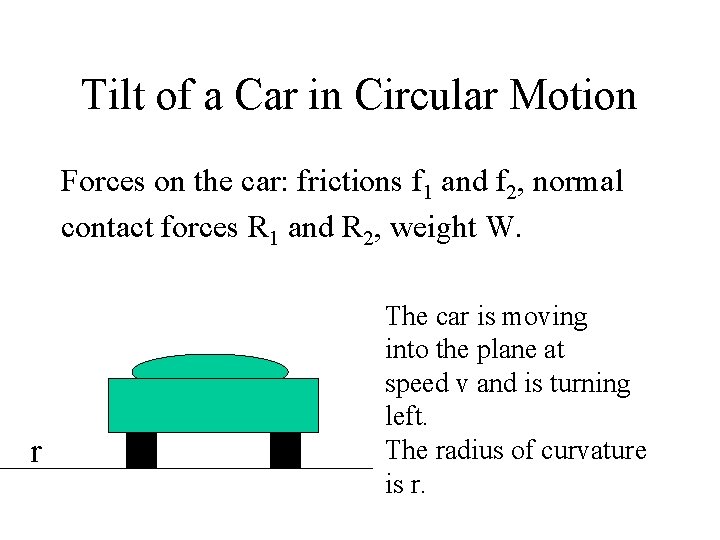
Tilt of a Car in Circular Motion Forces on the car: frictions f 1 and f 2, normal contact forces R 1 and R 2, weight W. r The car is moving into the plane at speed v and is turning left. The radius of curvature is r.
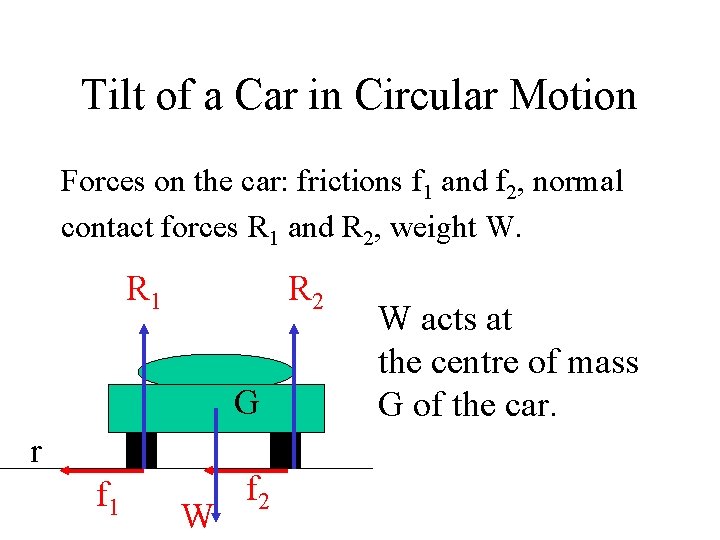
Tilt of a Car in Circular Motion Forces on the car: frictions f 1 and f 2, normal contact forces R 1 and R 2, weight W. R 1 R 2 G r f 1 W f 2 W acts at the centre of mass G of the car.

Tilt of a Car in Circular Motion Forces on the car: frictions f 1 and f 2, normal contact forces R 1 and R 2, weight W. R 1 R 2 G r f 1 W f 2 We are going to compare R 1 and R 2.
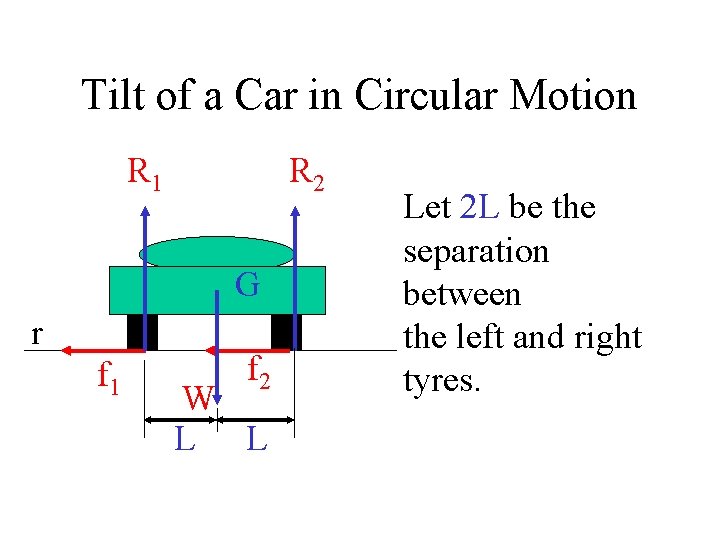
Tilt of a Car in Circular Motion R 1 R 2 G r f 1 f 2 W L L Let 2 L be the separation between the left and right tyres.
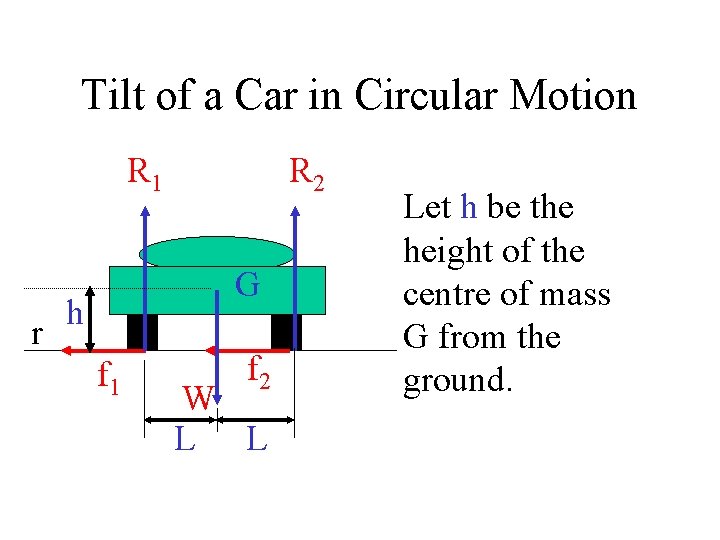
Tilt of a Car in Circular Motion R 1 r R 2 G h f 1 f 2 W L L Let h be the height of the centre of mass G from the ground.
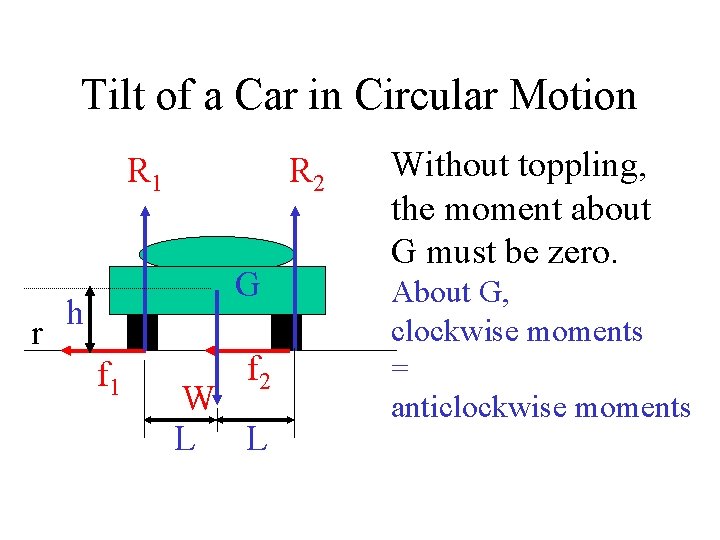
Tilt of a Car in Circular Motion R 1 r R 2 G h f 1 f 2 W L L Without toppling, the moment about G must be zero. About G, clockwise moments = anticlockwise moments

Tilt of a Car in Circular Motion R 1 r R 2 G h f 1 f 2 W L L So R 2 > R 1

Tilt of a Car in Circular Motion As R 2 > R 1, the springs on the right are compressed more. R 1 R 2 The car tilts right when it turns left. G r f 1 W f 2 http: //www. sciencejoywagon. com/physicszone/lesson/03 circ/centrif. htm

Uniform Motion in a Vertical Circle • The path is the circumference of a vertical circle with constant radius r. • The speed is v, a constant. • The mass of the object is m.
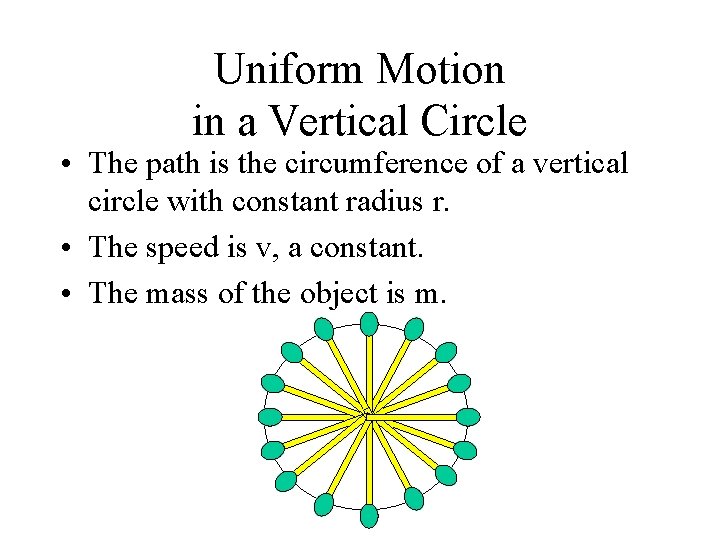
Uniform Motion in a Vertical Circle • The path is the circumference of a vertical circle with constant radius r. • The speed is v, a constant. • The mass of the object is m.
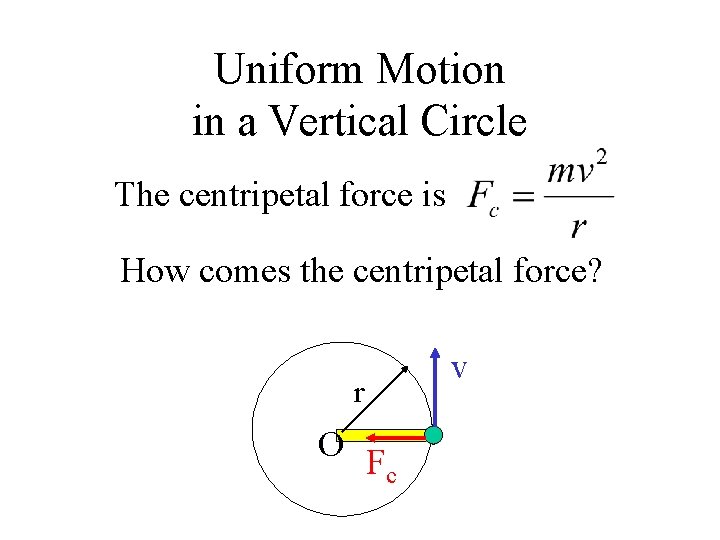
Uniform Motion in a Vertical Circle The centripetal force is How comes the centripetal force? r O F c v
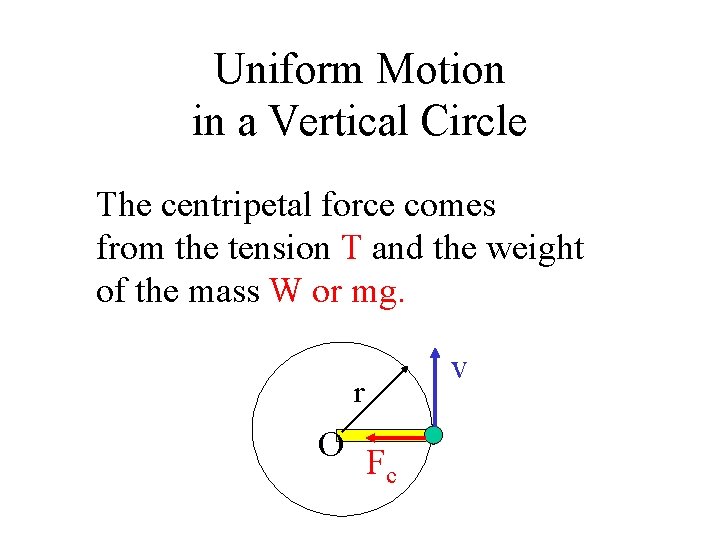
Uniform Motion in a Vertical Circle The centripetal force comes from the tension T and the weight of the mass W or mg. r O F c v
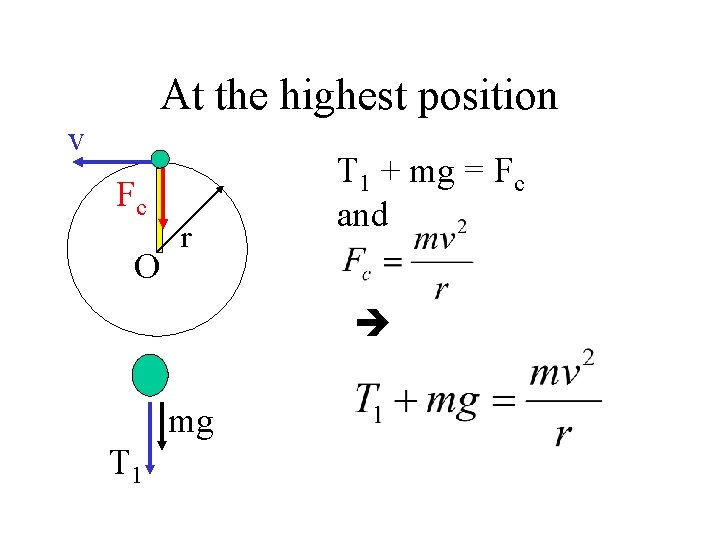
At the highest position v Fc O r T 1 + mg = Fc and mg T 1
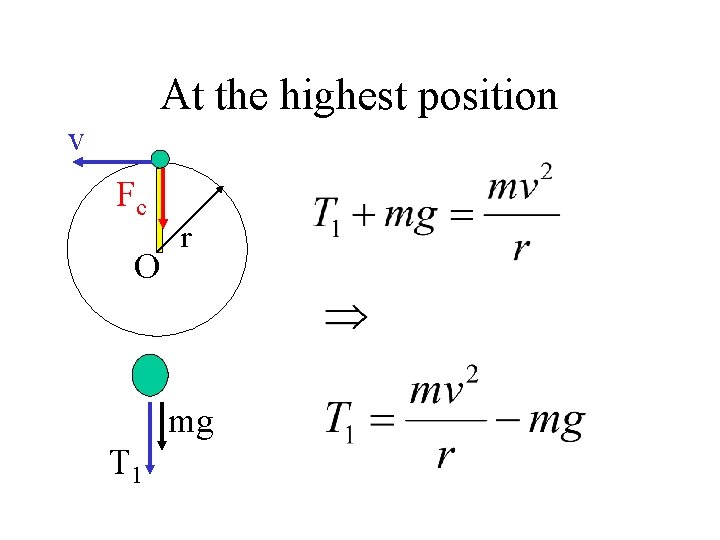
At the highest position v Fc O r mg T 1

At the highest position v Fc O r What would happen mg T 1 if v 2 = ?
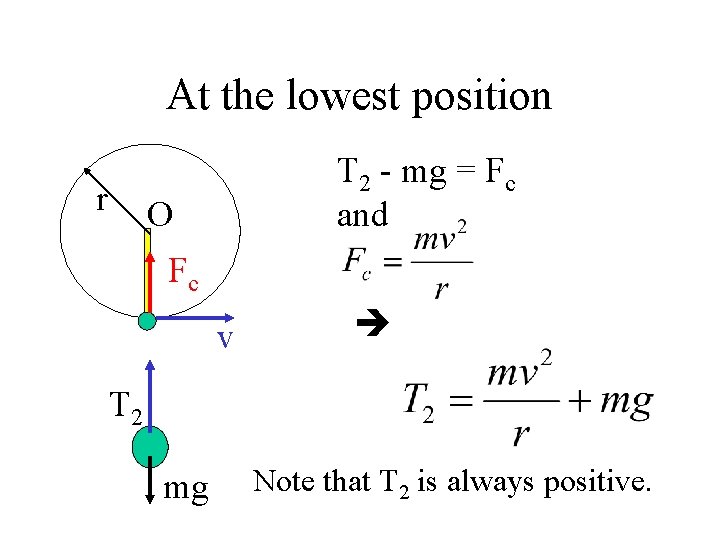
At the lowest position r T 2 - mg = Fc and O Fc v T 2 mg Note that T 2 is always positive.

At any other positions O r There are three forces on the mass. T 3 F v T 3 is the tension from θ the rod, F is force from the rod mg and mg is the weight of the mass
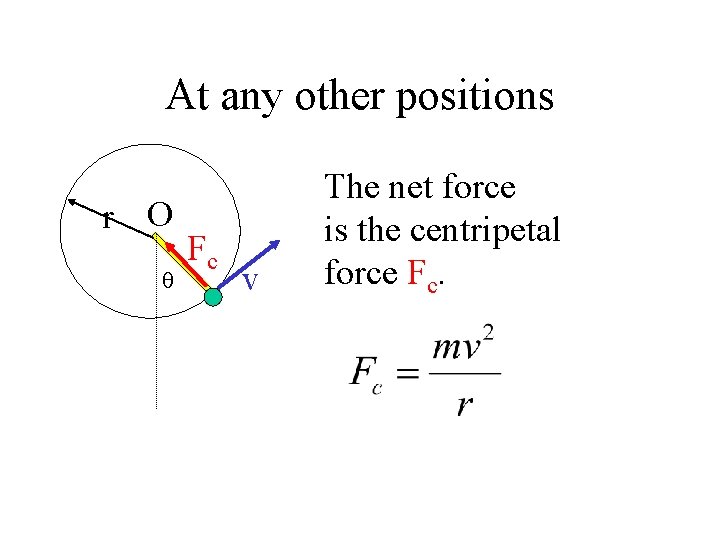
At any other positions O r θ Fc v The net force is the centripetal force Fc.
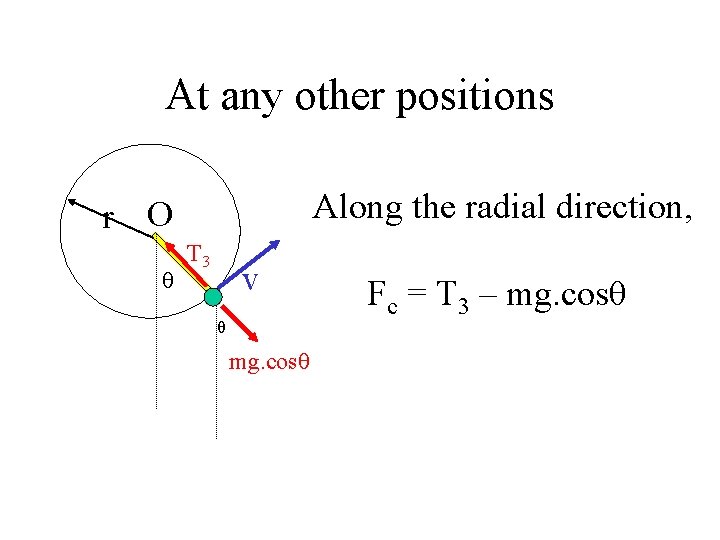
At any other positions Along the radial direction, O r θ T 3 v θ mg. cosθ Fc = T 3 – mg. cosθ
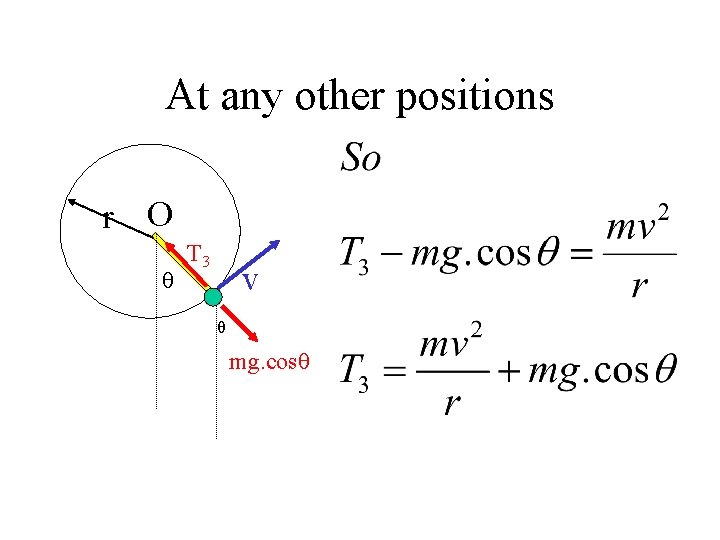
At any other positions O r θ T 3 v θ mg. cosθ
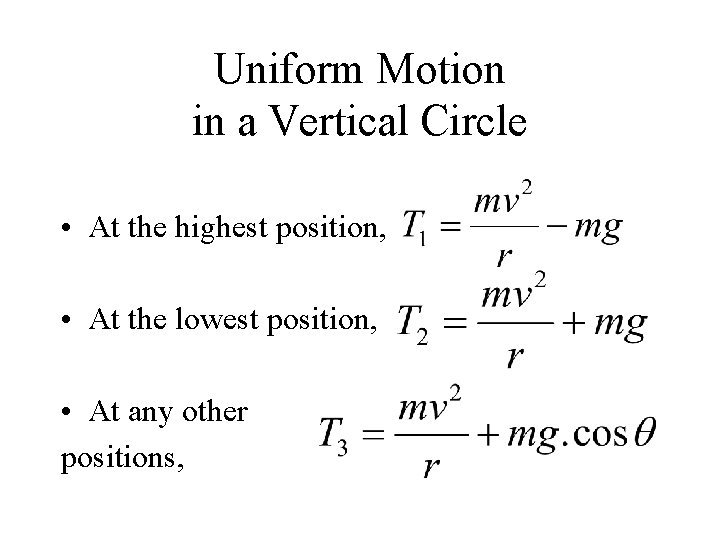
Uniform Motion in a Vertical Circle • At the highest position, • At the lowest position, • At any other positions,
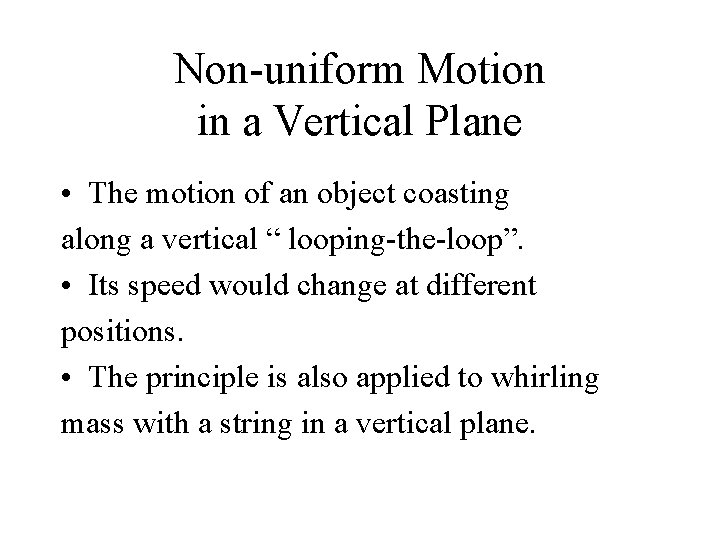
Non-uniform Motion in a Vertical Plane • The motion of an object coasting along a vertical “ looping-the-loop”. • Its speed would change at different positions. • The principle is also applied to whirling mass with a string in a vertical plane.

Looping the loop • Mass of the marble is m. • Radius of the loop is r. • The marble starts at the lowest position with speed vo. r vo O
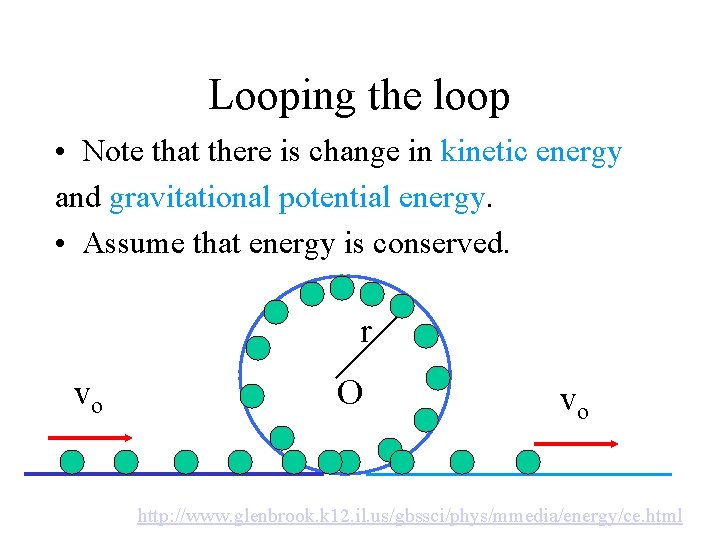
Looping the loop • Note that there is change in kinetic energy and gravitational potential energy. • Assume that energy is conserved. r vo O vo http: //www. glenbrook. k 12. il. us/gbssci/phys/mmedia/energy/ce. html

Looping the loop • The speed v of the marble changes on the loop. • The centripetal force changes on the loop. r v O v v

At the lowest position • The speed v 1 of the marble is vo. • The centripetal force Fc comes from the normal contact force N 1 and the weight of the marble mg. r O N 1 mg vo
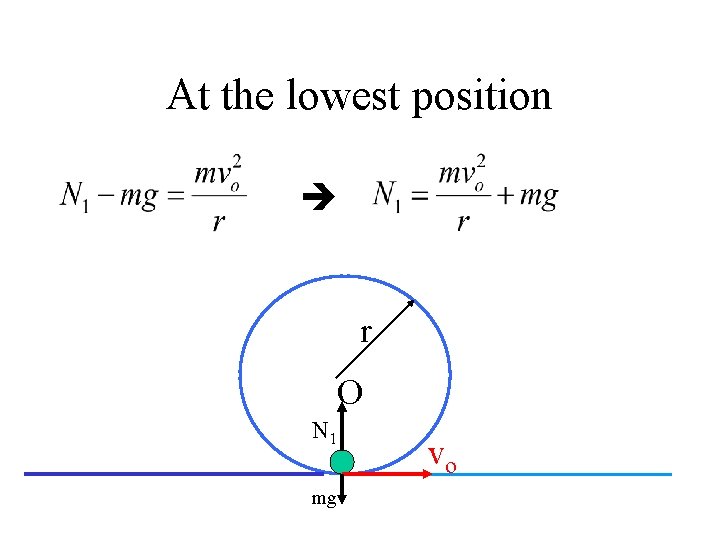
At the lowest position r O N 1 mg vo

Below the centre r O N 2 v 2 θ mg
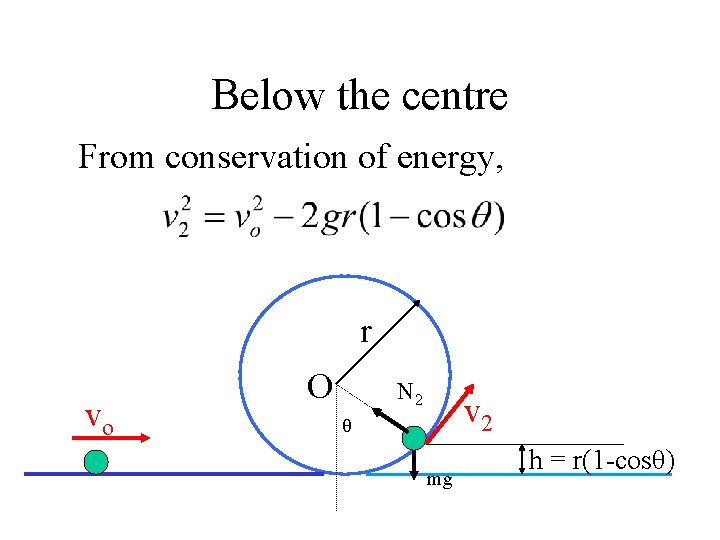
Below the centre From conservation of energy, r vo O N 2 v 2 θ mg h = r(1 -cosθ)

Above the centre v 3 r N 3 ψ O mg
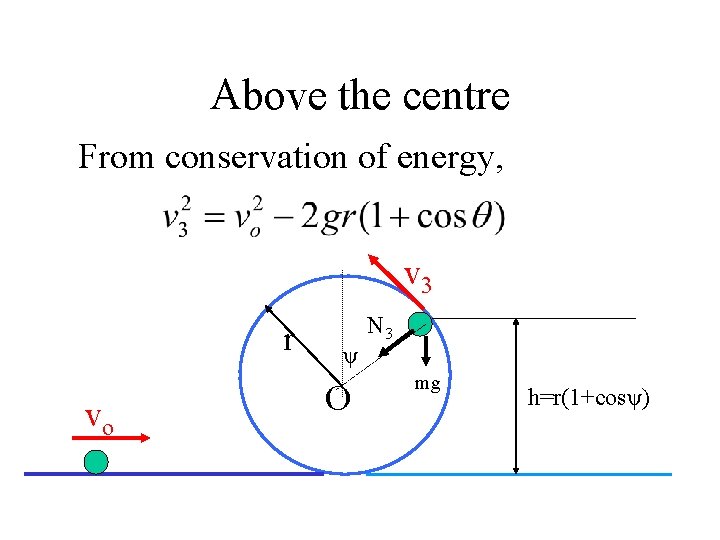
Above the centre From conservation of energy, v 3 r vo ψ O N 3 mg h=r(1+cosψ)
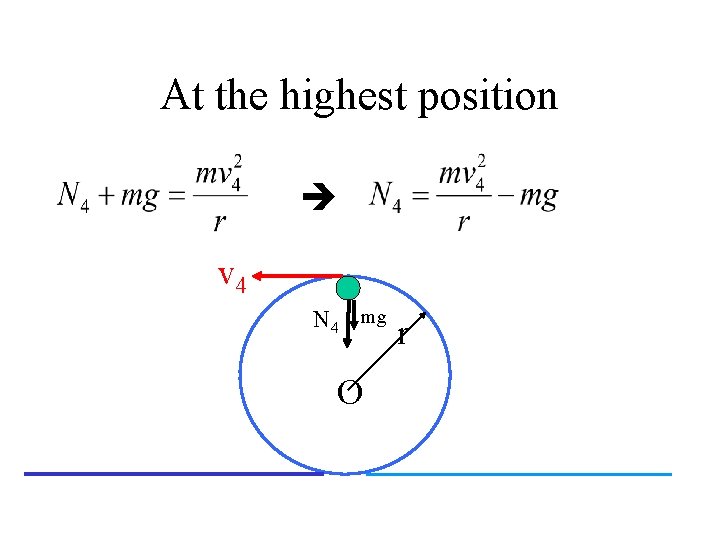
At the highest position v 4 N 4 mg O r
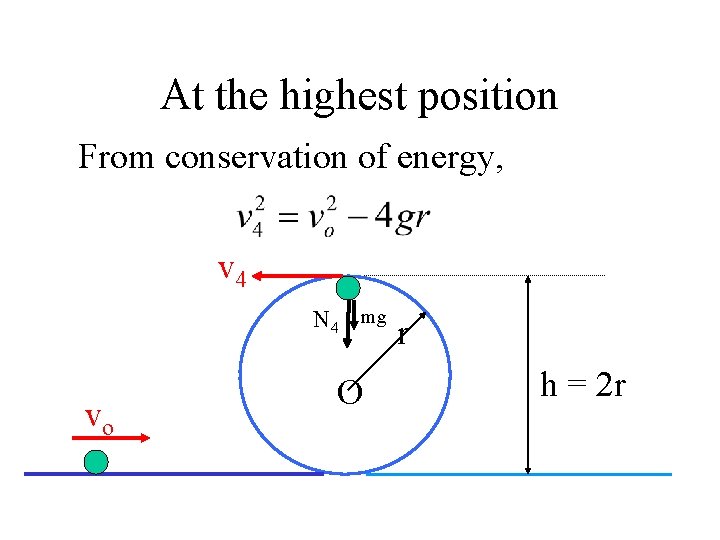
At the highest position From conservation of energy, v 4 N 4 mg vo O r h = 2 r

Completing the Circle • For the marble to reach the highest position, and
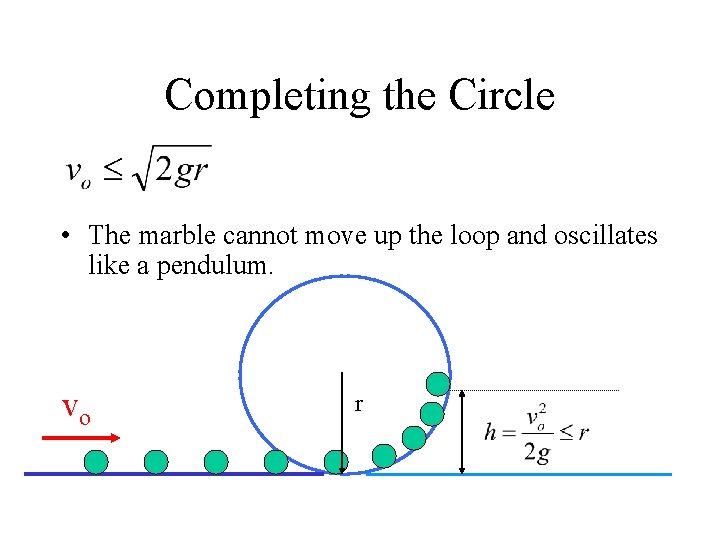
Completing the Circle • The marble cannot move up the loop and oscillates like a pendulum. vo r

Completing the Circle • The marble cannot move up the loop and oscillates like a pendulum. vo r
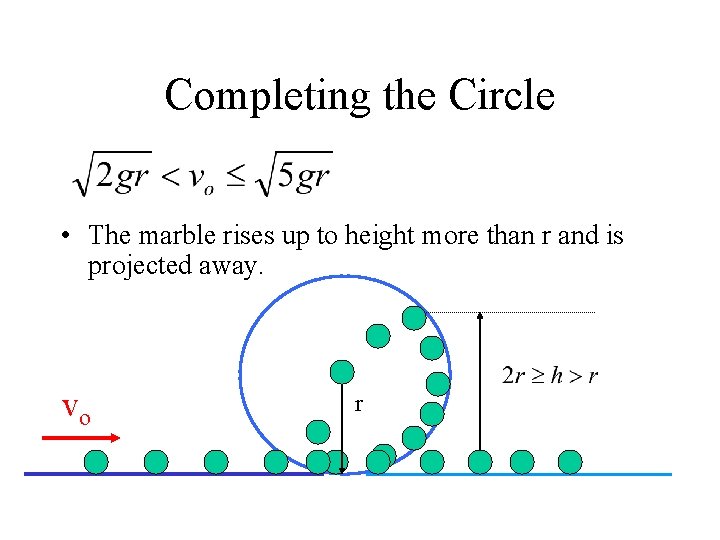
Completing the Circle • The marble rises up to height more than r and is projected away. vo r
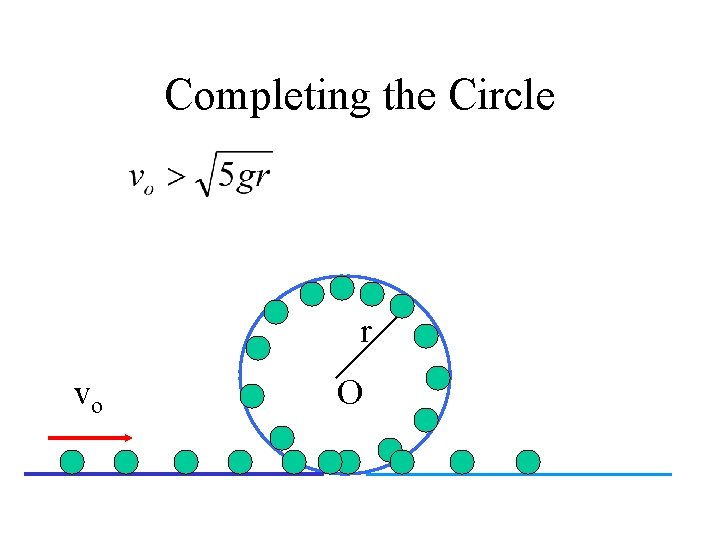
Completing the Circle r vo O
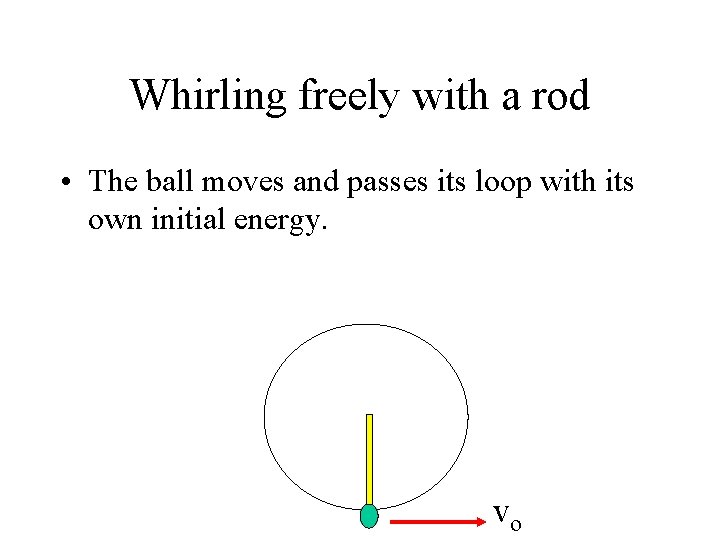
Whirling freely with a rod • The ball moves and passes its loop with its own initial energy. vo
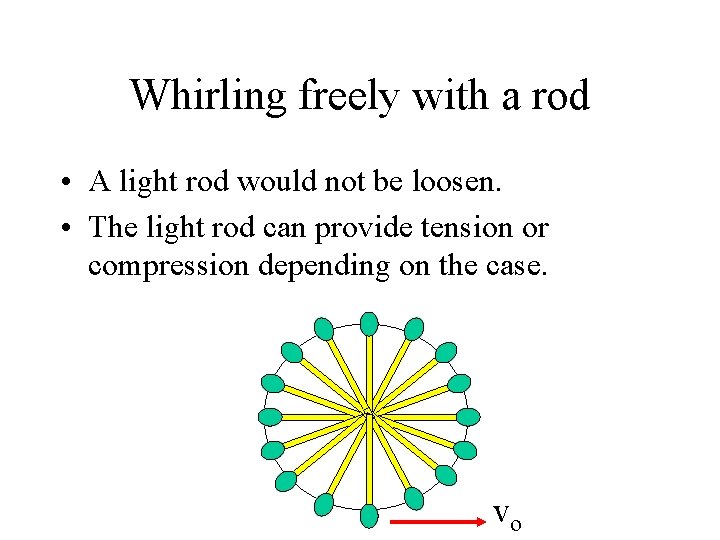
Whirling freely with a rod • A light rod would not be loosen. • The light rod can provide tension or compression depending on the case. vo
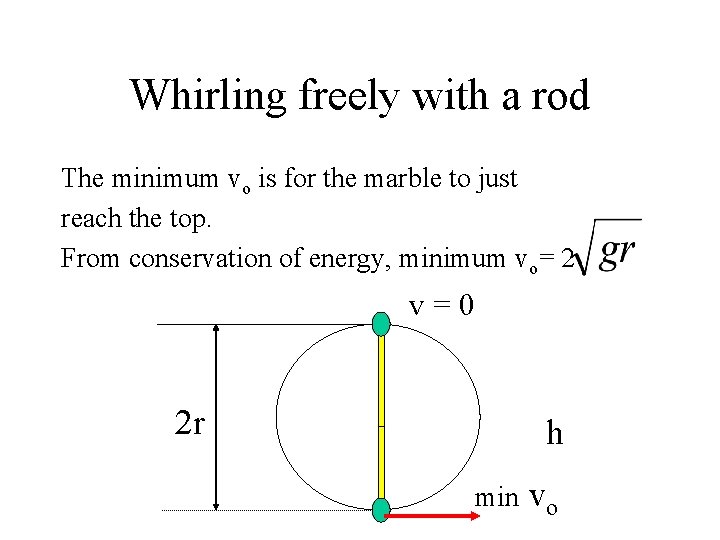
Whirling freely with a rod The minimum vo is for the marble to just reach the top. From conservation of energy, minimum vo= 2 v=0 2 r h min vo

Whirling freely with a rod v θ 2 r F θ min mg vo h=r(1+cosθ)
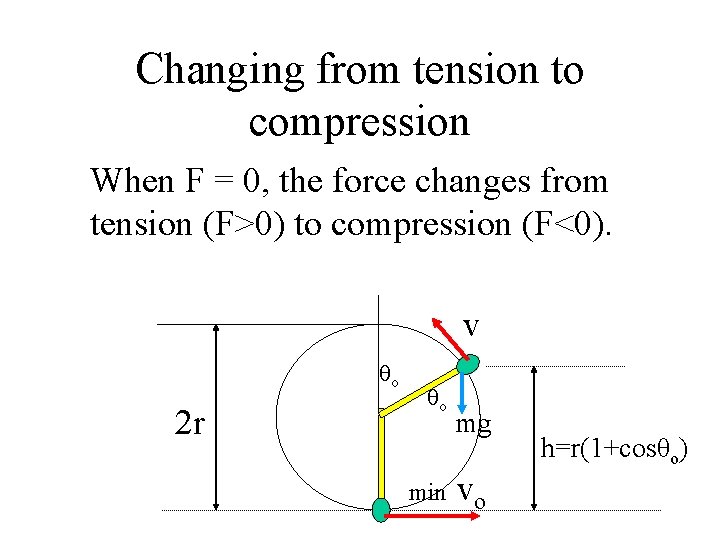
Changing from tension to compression When F = 0, the force changes from tension (F>0) to compression (F<0). v θo 2 r θo min mg vo h=r(1+cosθo)

Changing from tension to compression Prove that θo = 48. 2 o when F = 0. v θo 2 r θo min mg vo h=r(1+cosθo)

Example 12 • Whirling a bucket of water in a vertical circle.
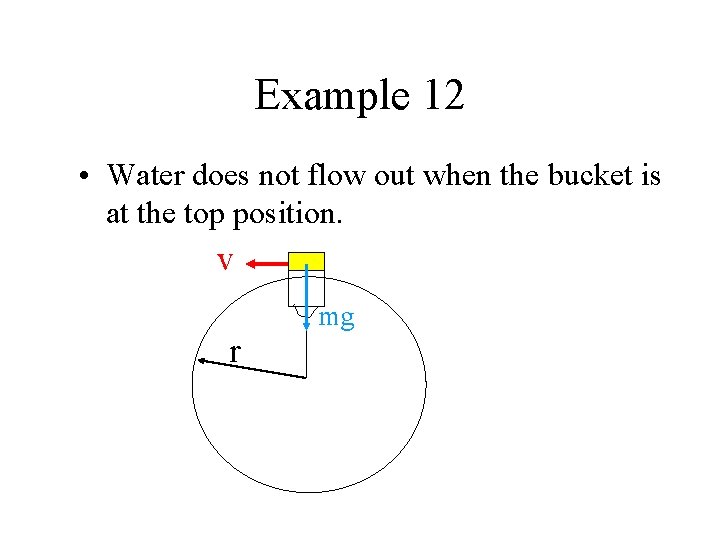
Example 12 • Water does not flow out when the bucket is at the top position. v r mg

Centrifuge • It is a device to separate solid or liquid particles of different densities by rotating them in a tube in a horizontal circle.

Centrifuge axis of rotation ω • ω is the angular velocity. • r is the distance of the small portion of liquid from the axis of rotation. r
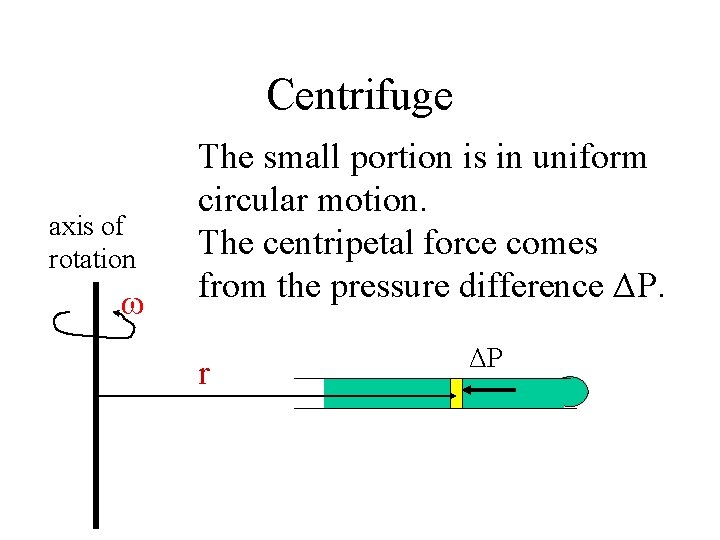
Centrifuge axis of rotation ω The small portion is in uniform circular motion. The centripetal force comes from the pressure difference ΔP. r ΔP
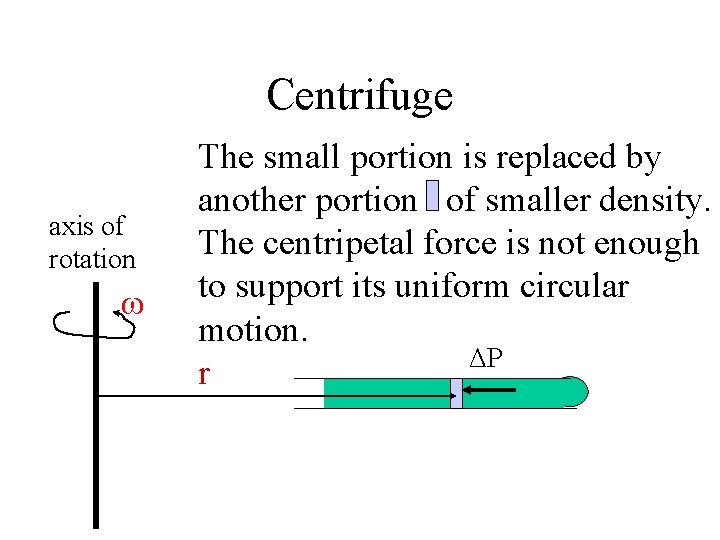
Centrifuge axis of rotation ω The small portion is replaced by another portion of smaller density. The centripetal force is not enough to support its uniform circular motion. ΔP r
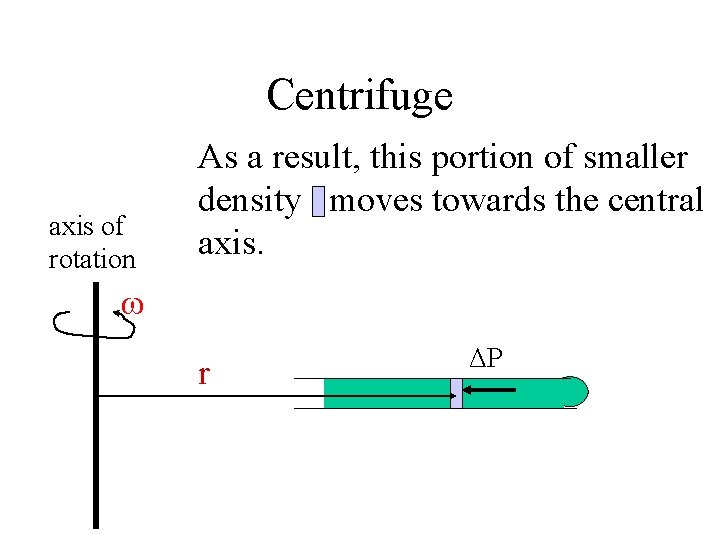
Centrifuge axis of rotation As a result, this portion of smaller density moves towards the central axis. ω r ΔP

Centrifuge axis of rotation Portion of larger density moves away from the central axis. ω r ΔP
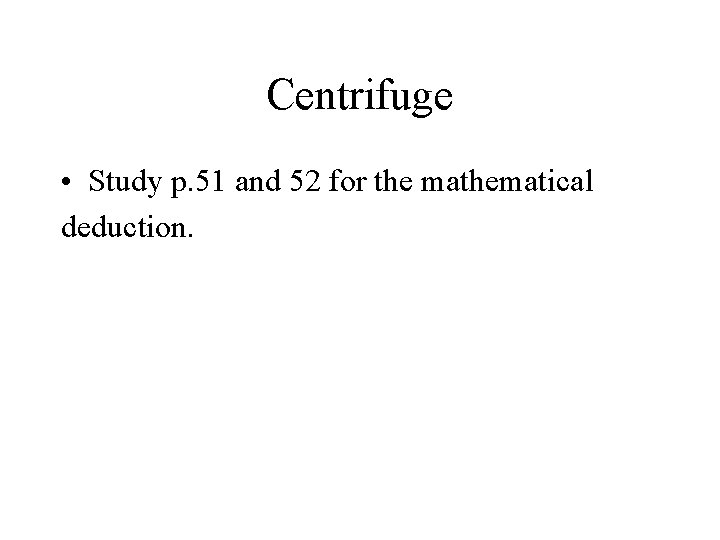
Centrifuge • Study p. 51 and 52 for the mathematical deduction.
- Slides: 161